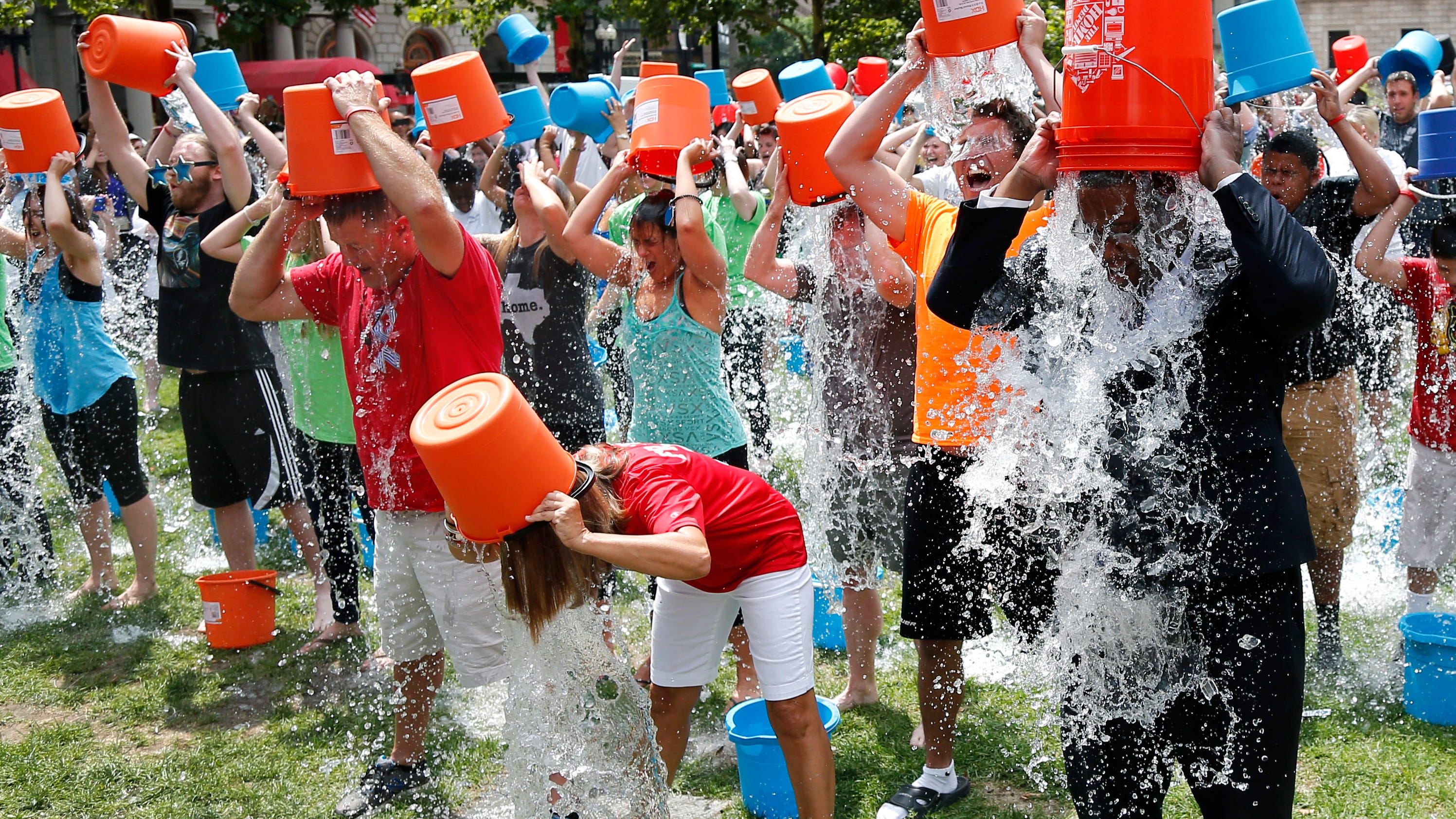In the summer of 2014, a simple act of dumping a bucket of ice water over one's head transformed into a global phenomenon, captivating millions and making an indelible mark on medical research. This was the rise of the Ice Bucket Challenge, a viral social media campaign that transcended borders, cultures, and demographics to achieve something truly remarkable. It wasn't just about fleeting internet fame; it was a powerful, grassroots movement that ignited awareness and spurred unprecedented fundraising for a devastating neurological disease: Amyotrophic Lateral Sclerosis (ALS).
This article delves into the heart of the Ice Bucket Challenge, exploring its humble beginnings, the passionate individuals who sparked its wildfire spread, and its profound impact on ALS research and care. We'll also uncover how this iconic challenge has been reimagined for new causes, proving that the spirit of viral giving can continue to make a difference, nearly a decade later.
Table of Contents
- The Genesis of a Global Phenomenon: How the Ice Bucket Challenge Began
- The ALS Connection and the Driving Force
- The Viral Explosion and Unprecedented Participation
- A Flood of Funds and Scientific Breakthroughs
- Beyond the Bucket: The Legacy of Awareness
- The Ice Bucket Challenge Reimagined for Mental Health
- The 10th Anniversary and a Thoughtful Return
- The Enduring Power of Viral Philanthropy
The Genesis of a Global Phenomenon: How the Ice Bucket Challenge Began
The Ice Bucket Challenge, which became a household name in 2014, didn't emerge from a corporate marketing strategy or a celebrity PR stunt. Instead, it blossomed from a series of interconnected events, rooted in personal connections and a desire to make a difference. While many attribute its widespread virality to the summer of 2014, its true origins trace back slightly earlier that year, evolving from a different kind of challenge. Initially, a similar challenge involving cold water was circulating for various causes, but it was professional golfer Chris Kennedy who is often credited with linking it directly to ALS. In the summer of 2014, Kennedy challenged his cousin, Jeanette Senerchia, to partake in the challenge in honor of her husband, Anthony Senerchia, who was living with ALS. This seemingly small act was a pivotal moment, as it began to narrow the focus of the challenge to ALS awareness and fundraising. The concept was simple yet brilliant: participants would film themselves dumping a bucket of ice water over their heads, then challenge others to do the same within 24 hours or donate to an ALS organization. Many chose to do both, amplifying the impact exponentially. This blend of public spectacle, personal challenge, and charitable giving created an irresistible formula for social media engagement. The simplicity of the act, coupled with its visual appeal, made it perfectly suited for platforms like Facebook, where it went viral in 2014, spreading like wildfire across newsfeeds and timelines.The ALS Connection and the Driving Force
The true engine behind the Ice Bucket Challenge's unprecedented success was its deep connection to ALS. Amyotrophic Lateral Sclerosis, often referred to as Lou Gehrig's disease, is a progressive neurodegenerative disease that affects nerve cells in the brain and spinal cord. It gradually robs individuals of their ability to move, speak, eat, and eventually breathe, while typically leaving their minds intact. It's a devastating diagnosis, and at the time, research funding and public awareness were sorely lacking. The challenge was sparked by three young men with ALS who became the unofficial faces of the movement: Pat Quinn, Pete Frates, and Anthony Senerchia. These individuals, living with the daily realities of ALS, courageously embraced the challenge, using their personal struggles to inspire millions. Their resilience and determination transformed a quirky internet trend into a powerful advocacy tool. They understood the urgent need for research and care, and their participation gave the challenge an authentic, deeply personal resonance that resonated with people worldwide. Their networks, including friends, family, and eventually celebrities and public figures, picked up the mantle, ensuring the message reached far and wide.The Pioneers of the Challenge
While the Ice Bucket Challenge became a collective effort, the stories of Pat Quinn, Pete Frates, and Anthony Senerchia are central to its legacy. They didn't just participate; they were the catalysts who infused the challenge with purpose and urgency. * **Pat Quinn:** Diagnosed with ALS in 2013, Quinn was a passionate advocate who tirelessly promoted the challenge. He understood the power of social media and helped guide the movement, ensuring its focus remained on ALS. His unwavering spirit, even as his health declined, inspired countless individuals to take part. * **Pete Frates:** A former Boston College baseball captain, Frates was diagnosed with ALS in 2012 at the age of 27. His athletic background and charismatic personality made him a natural leader. He famously took the challenge himself, inspiring his vast network of friends, teammates, and supporters to join in. His family played a crucial role in amplifying his message and ensuring the challenge gained national attention. * **Anthony Senerchia:** As mentioned, his diagnosis was the initial impetus for Chris Kennedy to challenge Jeanette Senerchia, thereby directly linking the challenge to ALS. Anthony's story was a poignant reminder of the personal toll of the disease, providing a tangible reason for people to donate. These three men, along with their families and communities, turned a simple act into a global phenomenon that changed the fight against ALS forever. Their courage and vision laid the groundwork for a movement that would raise millions and fundamentally alter the landscape of ALS research.The Viral Explosion and Unprecedented Participation
The summer of 2014 witnessed an unprecedented media frenzy. What started as a small, personal initiative quickly exploded onto the global stage. Friends challenged friends, teachers challenged students, and soon, celebrities, athletes, billionaires, and even former presidents were dumping buckets of ice water over their heads. The visual nature of the challenge, combined with the social pressure of being "called out" by a friend or idol, created a perfect storm for viral spread. Over 17 million people participated in the Ice Bucket Challenge, creating a cascade of videos across social media platforms. From Hollywood stars like Leonardo DiCaprio and Jennifer Aniston to tech titans like Mark Zuckerberg and Bill Gates, and even political figures like George W. Bush, the sheer breadth of participation was staggering. Each video served as a public endorsement, a call to action, and a testament to the collective power of social media for good. This widespread engagement ensured that the message of ALS awareness reached corners of the world that traditional campaigns might never have touched. The challenge became a global phenomenon, breaking through the noise of daily internet content and capturing the world's attention for a critical cause.A Flood of Funds and Scientific Breakthroughs
The primary goal of the Ice Bucket Challenge was not just awareness, but also to raise funds for ALS research and care. In this regard, it was an overwhelming success. The campaign raised an astonishing $115 million for the ALS Association in 2014 alone. This massive influx of donations transformed the financial landscape for ALS research. An independent research organization reported that donations from the 2014 ALS Ice Bucket Challenge enabled the ALS Association to increase its annual funding for research around the world by an incredible 187 percent. This wasn't just a temporary boost; it was a sustained investment that allowed researchers to accelerate their work significantly. During this time, ALS researchers made scientific advances, leading to crucial discoveries that had previously been out of reach due to lack of funding. The increased investment also meant that care for people living with ALS expanded, improving their quality of life. Furthermore, the public attention generated by the challenge spurred greater investment in disease research from the federal government, creating a ripple effect of funding. One of the most significant scientific breakthroughs directly attributed to the Ice Bucket Challenge funding was the discovery of the NEK1 gene, a major gene associated with ALS. This discovery, announced in 2016, was a monumental step forward, providing new targets for drug development and offering a deeper understanding of the disease's mechanisms. The legacy of the Ice Bucket Challenge is therefore not just about viral videos, but about tangible scientific progress that continues to bring us closer to effective treatments and, ultimately, a cure for ALS. The long-term vision, as articulated by many in the ALS community, is to "Make ALS livable by 2030," a goal made more attainable by the challenge's impact.Beyond the Bucket: The Legacy of Awareness
While the financial impact of the Ice Bucket Challenge was undeniable, its legacy extends far beyond the millions raised. It fundamentally transformed ALS awareness. Before 2014, many people had little to no understanding of ALS. The challenge put the disease squarely in the global spotlight, educating millions about its devastating effects and the urgent need for research. It demonstrated the immense power of social media as a tool for social good, proving that a simple, shareable concept could mobilize a global community for a serious cause. The challenge broke down barriers, making a complex medical condition accessible and understandable to the general public. It fostered empathy and connection, as participants learned about the individuals behind the cause and shared their own reasons for participating. The Ice Bucket Challenge showed that collective action, even through a seemingly trivial act, can lead to profound and lasting change, leaving a permanent mark on public consciousness regarding ALS.The Ice Bucket Challenge Reimagined for Mental Health
Nearly a decade after its initial viral explosion, the Ice Bucket Challenge has resurfaced with a new mission, demonstrating its enduring adaptability and power. In 2025, it has been reimagined by students at the University of South Carolina, now with a crucial focus on mental health awareness and suicide prevention. This revival showcases the challenge's potential to transcend its original purpose and address other pressing societal issues. The revival was brought about by a group of students at the University of South Carolina to benefit Active Minds, a leading nonprofit organization supporting mental health awareness and education for young adults. Recognizing the significant challenges young adults face regarding mental health conditions, these students saw an opportunity to leverage a proven viral format to break the stigma and raise vital funds.The #SpeakYourMind Movement of 2025
The #SpeakYourMind Ice Bucket Challenge of 2025 is a viral campaign specifically designed to raise funds and break the stigma around mental health issues. It was created by students at the University of South Carolina’s “Mental Illness Needs Discussion” (MIND) club, which first posted about the challenge on March 31. The goal is to encourage open conversations about mental health, reduce feelings of isolation, and promote seeking help. The rules are familiar: dump ice water, challenge others, and donate. However, the emphasis is now firmly on the message. Participants are encouraged to share personal stories or scientific facts about mental health, include donation links in their videos, and challenge others in ways that prioritize health and sustainability. This thoughtful approach aims to ensure that the challenge is not just a fleeting trend but a meaningful contribution to a critical cause. It highlights why this challenge is important for young adults, who often face unique pressures and may struggle to discuss their mental health openly. The majority of mental health conditions often begin in adolescence or early adulthood, making this targeted campaign particularly vital for this demographic.The 10th Anniversary and a Thoughtful Return
As we approach the 10th anniversary of the original ALS Ice Bucket Challenge, the enduring impact of the 2014 phenomenon is still being celebrated and built upon. Our friend John Russo, a dedicated advocate, invites the community to join him in raising funds for ALS research at ALS TDI (ALS Therapy Development Institute). Throughout August, he has pledged to match up to $25,000 of all donations, demonstrating the continued commitment to the original cause that sparked the global movement. This ongoing dedication ensures that the initial surge of funding continues to fuel vital research efforts. In 2025, the Ice Bucket Challenge is being revisited with a more thoughtful approach, moving beyond just the spectacle. Organizations are urging participants to include donation links in their videos, share personal stories or scientific facts about ALS, and challenge others in ways that prioritize health and sustainability. This evolution reflects a maturity in viral philanthropy, recognizing that while virality can capture attention, sustained impact requires deeper engagement and education.A Call for Conscious Participation
The return of the Ice Bucket Challenge, whether for ALS or mental health, emphasizes a call for conscious participation. It's no longer just about the splash; it's about the message, the donation, and the sustained commitment to the cause. By encouraging participants to share personal stories or scientific facts, the challenge becomes a powerful educational tool. By prioritizing health and sustainability in the way challenges are issued, it adapts to modern sensibilities and ensures the movement remains positive and impactful. This thoughtful approach ensures that the Ice Bucket Challenge remains more than just a trend – it's a vehicle for enduring change.The Enduring Power of Viral Philanthropy
The Ice Bucket Challenge stands as a testament to the extraordinary power of collective action, fueled by social media and genuine human empathy. It started with a few brave individuals living with ALS, spread by their networks, celebrities, and millions of people worldwide, culminating in a global phenomenon that raised millions for ALS research in 2014. The goal of the challenge was clear: to raise awareness and funds for ALS research and care, and it achieved this beyond anyone's wildest expectations. From scientific breakthroughs like the discovery of the NEK1 gene to a dramatic increase in research funding and public awareness, the legacy of the Ice Bucket Challenge is undeniable. It demonstrated that a simple, engaging concept can transform a niche cause into a global conversation. Its recent reimagining for mental health awareness further proves its adaptability and enduring relevance as a tool for social good. The Ice Bucket Challenge reminds us that when individuals come together, even through a seemingly small act, they can create a ripple effect of compassion that leads to monumental change. What cause will it champion next? Only time will tell, but its impact on philanthropy and social advocacy will continue to resonate for years to come.What are your memories of the Ice Bucket Challenge? Did you participate, or did it inspire you to learn more about ALS or mental health? Share your thoughts in the comments below! And if you're interested in learning more about the ongoing fight against ALS or mental health advocacy, explore other articles on our site dedicated to these vital causes.


